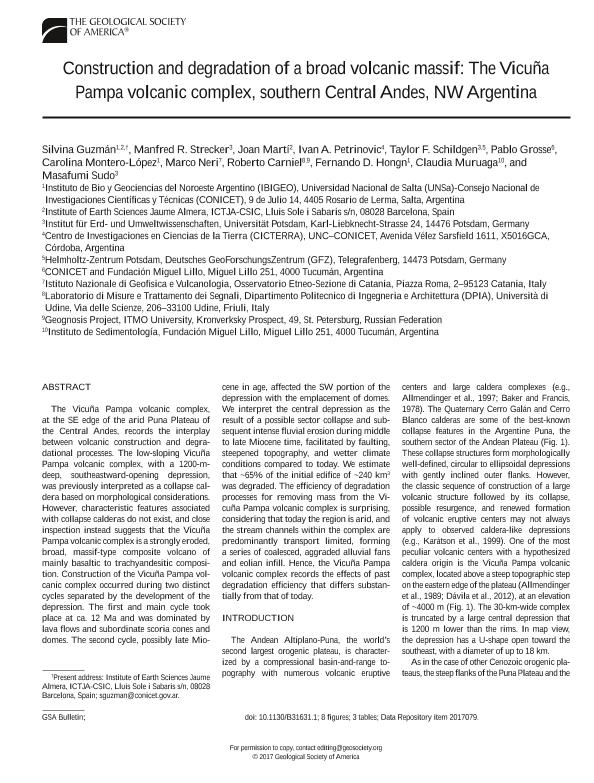Artículo
Construction and degradation of a broad volcanic massif: The Vicuña pampa volcanic complex, southern central Andes, NW Argentina
Guzman, Silvina Raquel ; Strecker, Manfred R.; Martí, Joan; Petrinovic, Ivan Alejandro
; Strecker, Manfred R.; Martí, Joan; Petrinovic, Ivan Alejandro ; Schildgen, Taylor F.; Grosse, Pablo
; Schildgen, Taylor F.; Grosse, Pablo ; Montero Lopez, Maria Carolina
; Montero Lopez, Maria Carolina ; Neri, Marco; Carniel, Roberto; Hongn, Fernando Daniel
; Neri, Marco; Carniel, Roberto; Hongn, Fernando Daniel ; Muruaga, Claudia Marcela
; Muruaga, Claudia Marcela ; Sudo, Masafumi
; Sudo, Masafumi
 ; Strecker, Manfred R.; Martí, Joan; Petrinovic, Ivan Alejandro
; Strecker, Manfred R.; Martí, Joan; Petrinovic, Ivan Alejandro ; Schildgen, Taylor F.; Grosse, Pablo
; Schildgen, Taylor F.; Grosse, Pablo ; Montero Lopez, Maria Carolina
; Montero Lopez, Maria Carolina ; Neri, Marco; Carniel, Roberto; Hongn, Fernando Daniel
; Neri, Marco; Carniel, Roberto; Hongn, Fernando Daniel ; Muruaga, Claudia Marcela
; Muruaga, Claudia Marcela ; Sudo, Masafumi
; Sudo, Masafumi
Fecha de publicación:
01/05/2017
Editorial:
Geological Society of America
Revista:
Geological Society Of America Bulletin
ISSN:
0016-7606
Idioma:
Inglés
Tipo de recurso:
Artículo publicado
Clasificación temática:
Resumen
The Vicuña Pampa volcanic complex, at the SE edge of the arid Puna Plateau of the Central Andes, records the interplay between volcanic construction and degradational processes. The low-sloping Vicuña Pampa volcanic complex, with a 1200-mdeep, southeastward-opening depression, was previously interpreted as a collapse caldera based on morphological considerations. However, characteristic features associated with collapse calderas do not exist, and close inspection instead suggests that the Vicuña Pampa volcanic complex is a strongly eroded, broad, massif-type composite volcano of mainly basaltic to trachyandesitic composition. Construction of the Vicuña Pampa volcanic complex occurred during two distinct cycles separated by the development of the depression. The first and main cycle took place at ca. 12 Ma and was dominated by lava flows and subordinate scoria cones and domes. The second cycle, possibly late Miocene in age, affected the SW portion of the depression with the emplacement of domes. We interpret the central depression as the result of a possible sector collapse and subsequent intense fluvial erosion during middle to late Miocene time, facilitated by faulting, steepened topography, and wetter climate conditions compared to today. We estimate that ~65% of the initial edifice of ~240 km3 was degraded. The efficiency of degradation processes for removing mass from the Vicuña Pampa volcanic complex is surprising, considering that today the region is arid, and the stream channels within the complex are predominantly transport limited, forming a series of coalesced, aggraded alluvial fans and eolian infill. Hence, the Vicuña Pampa volcanic complex records the effects of past degradation efficiency that differs substantially from that of today.
Archivos asociados
Licencia
Identificadores
Colecciones
Articulos(IBIGEO)
Articulos de INST.DE BIO Y GEOCIENCIAS DEL NOA
Articulos de INST.DE BIO Y GEOCIENCIAS DEL NOA
Citación
Guzman, Silvina Raquel; Strecker, Manfred R.; Martí, Joan; Petrinovic, Ivan Alejandro; Schildgen, Taylor F.; et al.; Construction and degradation of a broad volcanic massif: The Vicuña pampa volcanic complex, southern central Andes, NW Argentina; Geological Society of America; Geological Society Of America Bulletin; 129; 5-6; 1-5-2017; 750-766
Compartir
Altmétricas



